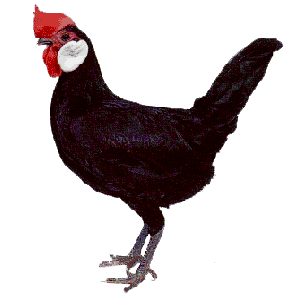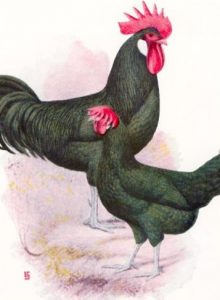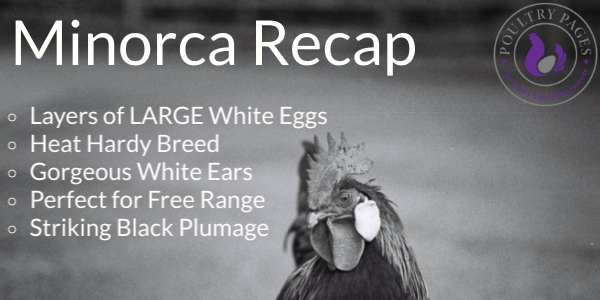
Minorca Breed Overview
Minorca chickens are the largest breed of all the Mediterranean breeds. Its renowned for its large white ear lobes and for being layers of large, gorgeous white chalky eggs. The Minorca originated from the Spanish isle of Menorca and has a large single comb a full tail and a set of legs that are ‘muscularly set under its body’.
Fun Fact: The Minorca was the favorite breed kept by T. E. Lawrence (Lawrence of Arabia).
The Minorca History in the UK
The Minorca first left Spain for England, where it was brought by English sailors and first registered in 1834. As they are today, they were then a large black chicken with large white earlobes adored for their large white eggs!
Being from Spain for easy recognition they were referred to as the Spanish chicken. [We now know the Spanish chicken to be something slightly different, having a white face and subsequently called the white faced Spanish chicken.] It is believed that the white faced Spanish chicken was infact created from the Minorca by selecting chickens with larger white earlobes and cross breeding them.
It is thought the Minorcas could have arrived into Britain as early as 1783 after Spanish merchant sailors decided to settle in England after the English declared peace with Spain after being at war with each other.
These sailors introduced the single comb black Minorca’s. Although they looked slightly different to what is the accepted looked today as the bird had a normal sized comb and was shorter and stockier.
In 1895 they were first exhibited in a separate class to the white faced Spanish chicken. From that, its popularity flourished and by was known all over England and the commonwealth as the ‘red faced Spanish chicken’.
As its popularity amongst poultry fanciers grew, so did the birds development, producing birds with larger and larger combs and over emphasizing the ear lobes. Not everyone at the time supported these changes.
The Minorca History in Europe
In 1880 the Germans had heard from England of the amazing Minorca [red faced Spanish] breed and they were very interested from the outset. However they didn’t like the English development of the bird, enlarging the comb and earlobes and not paying much attention to its egg production or other attributes.
So the Germans begin to create a version of the single comb Minorca thats body was more symmetrical, the ear lobes and comb were smaller and it did that by crossing it with the German breed called the Langshan, particularly black Langshans.
It wasn’t as successful as they had first hoped. The results produced what was known as the ‘German type’. Whilst they had been successful at reducing the comb and ear lobes size and creating a visually better looking body, the bird had other faults.
These faults were the females laid smaller brown tinted eggs and their feathers were a blueish purple. The resulting males had bronze feather coloring and reddish sheen legs.
This German type was then adopted by other countries including Denmark and Scandinavian countries.
A Dutch breeder at around this time was reported as saying, if you took the single comb Minorca and crossed it with the Orpington [a British breed] ‘’you had the most hardy and productive chicken ever known’’
The Minorca History in the US
The white faced Spanish chicken was already popular in America when the Minorca arrived on the scene, which was thought to be around the 1880’s.
It was mainly the ‘English version’ that was directly imported into the US and it was well received and thus became very popular as it was larger than the standard Leghorn and laid a larger egg.
They were also said to have good traits like the Spanish white faced chicken had, but more of them as it was hardier and possessed greater vigor. Think of it then as the ‘Spanish’ upgrade – the version 2.0!
They were perfect for the US climate, as temperatures across the hot dry southern states is similar to that of the Mediterranean. Plus it had become accustomed to the cold winters in the north of England, so did fairly well in northern US states too. However the large comb is susceptible to frost bite, in extreme cold.
Because of the sometimes freezing comb, there was a drive to create a smaller combed bird and they did actually succeed. They created a Rose Comb Black and Rose Comb White. They did this by crossing the birds with Hamburgs and the rose comb Minorca’s still exist today but in very few numbers as they weren’t as popular as the standard single comb black.
At one point in the 1800’s it was thought that there was over 200 different types of Minorcas. The Minorca was first admitted to the American Poultry Association [A.P.A] in 1888 and is available today in both standard size and bantam.
Weights
The Standard Size cock weights 9 lb. (4.1 kg) and the standard hen weights 7.5 lb. (3.4 kg)
The Bantam Rose Comb cock weighs 26 oz. (740 g) with the hen weighing 24 oz. (680 g)
The Bantam Single Comb cock weighs 32 oz. (910 g) with the hen weighing 26 oz. (740 g)
Minorca Eggs
Size
Large – XL
Color
White/Chalky
Production per year
170-260 [more if you have a breed crossed with a Leghorn]
When do they start laying eggs?
About 18-20 weeks [they are early to mature]
Minorca Characteristics
Temperament / Are they good as pets?
They don’t go broody meaning they won’t stop laying eggs to sit on eggs to hatch out their own brood of chicks.
They are reported as being skittish when under a year old but do settle down into good layers.
Minorca’s are quite independent so are the perfect pet if you just want to ‘leave them to it’, they are a fairly low maintenance hardy breed.
How do I tame Minorca’s?
Well, being independent it can be tough to tame them up but its not too difficult. The best way is to handle them as chicks 3-4 times a day so they get used to being picked up. This will build up a bond with them that will remain for their whole lives.
As adults try feeding them some treats. Gradually they will build up to eating the treats from your hands and then may enjoy a cuddle or two!
How many do I need to buy?
It’s never recommended to keep chickens in less than a pair. This is because they are social creatures enjoying company.
The best ratio for keeping Minorcas is 8:1. That’s 1 male for every 8 females.
How much space do they need?
Better suited to free range but will tolerate some confinement. The roosters are fairly large birds so id allow 4-5sqft minimum, per bird of coop space and 4sqft per bird for the hens which are smaller. In free range conditions they become good foragers meaning they will source some of their own food – great for your feed bill.
Minimum run or outside space typically for most breeds is 8sqft per bird however Minorca’s enjoy being free range and being slightly larger I’d say 12-15sqft per bird would be a better estimation.
Bare in mind an unhappy Minorca will lay less eggs, so it’s really important for the hens welfare to provide it with comfortable surroundings.
Will they mix with my other chickens?
Yes they will mix well into any back yard flock. The males aren’t aggressive and the hens are fairly calm in nature. Its never recommended to mix less than 2 birds into any flock at one time. This is because introducing birds into a flock unbalances, for a short period, the natural order of things.
I’m talking specifically about the natural pecking order. The term pecking order comes from poultry! Bossy hens can assert their authority on the ‘new comers’ and so its therefore better to have a minimum of two birds introduced at any one time, so they have a ‘buddy’.
Appearance
Black Minorca’s are large in size, have black plumage and large wattles and ear lobes in that famous bright white color.
The earlobes are actually almond shaped. If their white ear lobes doesn’t clearly identify them the 6 pointed comb found on both the females and males should.
The rose comb found on the bantams are moderately large, covered with small rounded points. The rose comb starts off square at the front and then narrows evenly towards the back.
Feeding
What should I feed them?
From 0-6 weeks old Minorca chicks, should have lots of vigor and will need to be fed ‘chick crumb’ or ‘starter chick’. This feed contains the correct amount of protein they require to develop properly at this young age.
From 6 weeks onwards they need growers mash, which is specifically tailored to give them exactly what they need to get them to near maturity.
Just before they start to lay their first eggs, perhaps 1 or 2 weeks before, they need to be feeding on ‘layers pellets’. The bantams will need ‘bantams layers pellets’, these are just layers pellets in a smaller size as the bantams have smaller throats.
Layers pellets contain a balanced diet specially for laying chickens and differ from their feed previously up to this point.
The reason for introducing the feed 1-2 weeks before they start laying is so they can absorb all the nutrients from the pallets giving them all they need when the day comes to lay their first egg.
How much should I feed them?
Up to the point where they begin to lay, food is best topped up and left in a feeder. This is due to the fact as chicks they haven’t yet developed a feed schedule, often sleeping during the day and/or feeding at night.
As laying hens or adults they will typically eat 2.8oz-4.2oz (80-120g) per day per bird. They eat the lower end of that in summer as its hotter but they will drink more fluids. Then they eat more in the winter to burn calories to keep warm.
To help them during the winter mix in some corn or seeds into their feed. It will provide them with some extra nutrients to boost their immune system and help them with the extra calories required particularly in cold winters.
What can’t they eat?
Chickens can’t eat chocolate as it contains an ingredient that makes them very sick and can cause cardiac arrest if the amount they consume is large enough.
The other food chickens can’t eat is beans. Dried beans are even worse than non dried.
Ensure then you are vigilant if feeding chickens scraps from the table that beans cant sneak in, or if they are free range that they can’t find any bean plants growing.
What do I need to keep Minorcas?
Coop
Minorca’s roost at 2-4 feet off the ground so you will a coop that can accommodate this. They are very heat hardy and are fairly cold hardy but even so you need a good coop that will be warm enough in winter so their comb or wattles wont freeze.
TIP: to help prevent combs from freezing apply some Vaseline to it.
If you can’t free range them, id suggest a semi free range compromise. Something like a Giantex run as they are easy to put together, have long lasting galvanized poles and are light weight so easy enough to move. Plus they come in various sizes to suit your backyard setting.
They are surrounded by chicken wire that’s covered in PVC making them really strong and ensuring they will last a really long time. The walk in door provides easy to access and that can be latched locked or double secured with ties.
It’s perfect to allow birds to stretch their legs, forage and almost free range whilst maintaining the comfort that they are in a totally secure run. Try Amazon…
I have this same set up for one of our flocks on our farm and it works well. The bottom of the run can be secured into the ground too and you could even run an electric fence around it too. To lift up and move it to fresh grass takes all of 5 minutes including re setting up the electric fence.
Minorca Chickens for Sale
Really good ‘single comb black Minorca’ chicks are sold by Cackle Hatchery if you live in the US.




